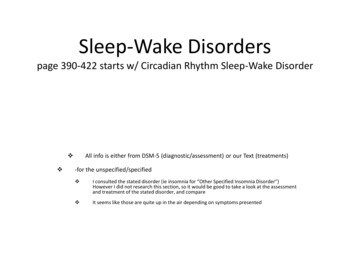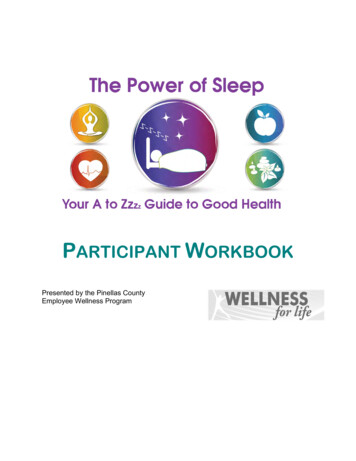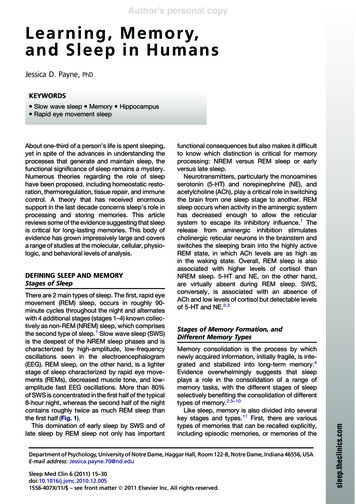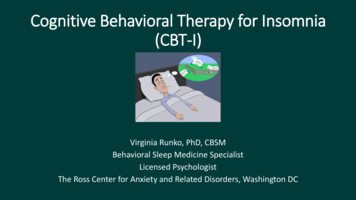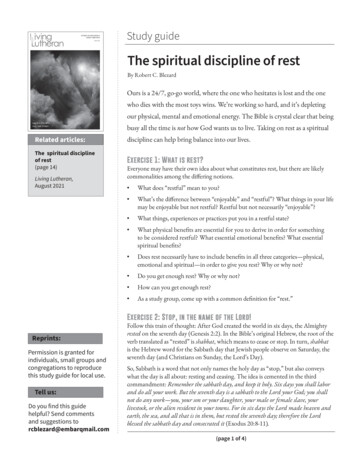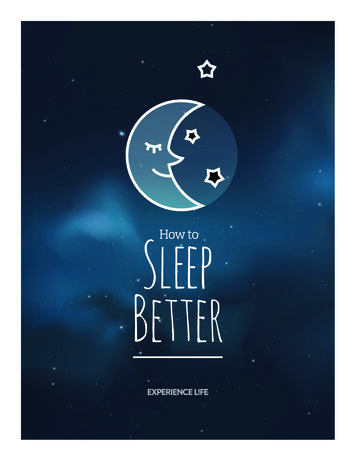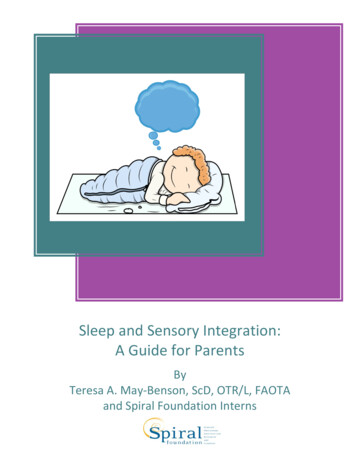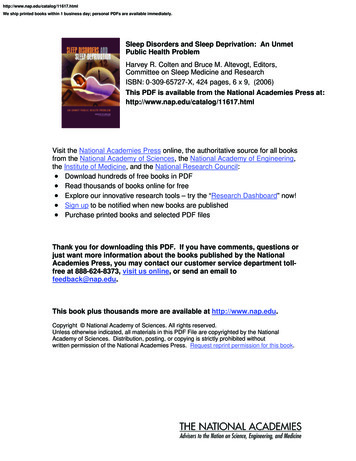
Transcription
http://www.nap.edu/catalog/11617.htmlWe ship printed books within 1 business day; personal PDFs are available immediately.Sleep Disorders and Sleep Deprivation: An UnmetPublic Health ProblemHarvey R. Colten and Bruce M. Altevogt, Editors,Committee on Sleep Medicine and ResearchISBN: 0-309-65727-X, 424 pages, 6 x 9, (2006)This PDF is available from the National Academies Press at:http://www.nap.edu/catalog/11617.htmlVisit the National Academies Press online, the authoritative source for all booksfrom the National Academy of Sciences, the National Academy of Engineering,the Institute of Medicine, and the National Research Council: Download hundreds of free books in PDF Read thousands of books online for free Explore our innovative research tools – try the “Research Dashboard” now! Sign up to be notified when new books are published Purchase printed books and selected PDF filesThank you for downloading this PDF. If you have comments, questions orjust want more information about the books published by the NationalAcademies Press, you may contact our customer service department tollfree at 888-624-8373, visit us online, or send an email tofeedback@nap.edu.This book plus thousands more are available at http://www.nap.edu.Copyright National Academy of Sciences. All rights reserved.Unless otherwise indicated, all materials in this PDF File are copyrighted by the NationalAcademy of Sciences. Distribution, posting, or copying is strictly prohibited withoutwritten permission of the National Academies Press. Request reprint permission for this book.
Sleep Disorders and Sleep Deprivation: An Unmet Public Health Problemhttp://www.nap.edu/catalog/11617.htmlSLEEP DISORDERS ANDSLEEP DEPRIVATIONAN UNMET PUBLIC HEALTH PROBLEMCommittee on Sleep Medicine and ResearchBoard on Health Sciences PolicyHarvey R. Colten and Bruce M. Altevogt, EditorsTHE NATIONAL ACADEMIES PRESSWashington, DCwww.nap.eduCopyright National Academy of Sciences. All rights reserved.
Sleep Disorders and Sleep Deprivation: An Unmet Public Health Problemhttp://www.nap.edu/catalog/11617.htmlTHE NATIONAL ACADEMIES PRESS 500 Fifth Street, N.W. Washington, DC 20001NOTICE: The project that is the subject of this report was approved by the Governing Board ofthe National Research Council, whose members are drawn from the councils of the NationalAcademy of Sciences, the National Academy of Engineering, and the Institute of Medicine. Themembers of the committee responsible for the report were chosen for their special competencesand with regard for appropriate balance.This study was supported by contracts between the National Academy of Sciences and theAmerican Academy of Sleep Medicine, the Department of Health and Human Services (contract No. N01-OD-4-2139), the National Sleep Foundation, and the Sleep Research Society.Any opinions, findings, conclusions, or recommendations expressed in this publication arethose of the author(s) and do not necessarily reflect the view of the organizations or agenciesthat provided support for this project.Library of Congress Cataloging-in-Publication DataSleep disorders and sleep deprivation : an unmet public health problem / Committee on SleepMedicine and Research, Board on Health Sciences Policy ; Harvey R. Colten and Bruce M.Altevogt, editors.p. ; cm.Includes bibliographical references and index.Supported by contracts between the National Academy of Sciences and the AmericanAcademy of Sleep Medicine, the Department of Health and Human Services, the NationalSleep Foundation, and the Sleep Research Society Contract no. N01-OD-4-2139ISBN 0-309-10111-5 (hardback)1. Sleep disorders—Social aspects. 2. Sleep deprivation—Social aspects. 3. Sleep—Socialaspects. 4. Public health. I. Colten, Harvey R. II. Altevogt, Bruce M. III. Institute ofMedicine (U.S.). Committee on Sleep Medicine and Research.[DNLM: 1. Sleep Disorders—United States. 2. Health Policy—United States. 3. SleepDeprivation—United States. WM 188 S63178 2006]RC547.S554 2006362.196′8498—dc222006014107Additional copies of this report are available from the National Academies Press, 500 FifthStreet, N.W., Lockbox 285, Washington, DC 20055; (800) 624-6242 or (202) 334-3313 (in theWashington metropolitan area); Internet, http://www.nap.edu.For more information about the Institute of Medicine, visit the IOM home page at:www.iom.edu.Copyright 2006 by the National Academy of Sciences. All rights reserved.Printed in the United States of America.The serpent has been a symbol of long life, healing, and knowledge among almost all culturesand religions since the beginning of recorded history. The serpent adopted as a logotype by theInstitute of Medicine is a relief carving from ancient Greece, now held by the Staatliche Museenin Berlin.Copyright National Academy of Sciences. All rights reserved.
Sleep Disorders and Sleep Deprivation: An Unmet Public Health wing is not enough; we must apply.Willing is not enough; we must do.”—GoetheAdvising the Nation. Improving Health.Copyright National Academy of Sciences. All rights reserved.
Sleep Disorders and Sleep Deprivation: An Unmet Public Health Problemhttp://www.nap.edu/catalog/11617.htmlThe National Academy of Sciences is a private, nonprofit, self-perpetuating societyof distinguished scholars engaged in scientific and engineering research, dedicated tothe furtherance of science and technology and to their use for the general welfare.Upon the authority of the charter granted to it by the Congress in 1863, the Academy has a mandate that requires it to advise the federal government on scientific andtechnical matters. Dr. Ralph J. Cicerone is president of the National Academy ofSciences.The National Academy of Engineering was established in 1964, under the charter ofthe National Academy of Sciences, as a parallel organization of outstanding engineers. It is autonomous in its administration and in the selection of its members,sharing with the National Academy of Sciences the responsibility for advising thefederal government. The National Academy of Engineering also sponsors engineering programs aimed at meeting national needs, encourages education and research,and recognizes the superior achievements of engineers. Dr. Wm. A. Wulf is presidentof the National Academy of Engineering.The Institute of Medicine was established in 1970 by the National Academy of Sciences to secure the services of eminent members of appropriate professions in theexamination of policy matters pertaining to the health of the public. The Instituteacts under the responsibility given to the National Academy of Sciences by its congressional charter to be an adviser to the federal government and, upon its owninitiative, to identify issues of medical care, research, and education. Dr. Harvey V.Fineberg is president of the Institute of Medicine.The National Research Council was organized by the National Academy of Sciencesin 1916 to associate the broad community of science and technology with theAcademy’s purposes of furthering knowledge and advising the federal government.Functioning in accordance with general policies determined by the Academy, theCouncil has become the principal operating agency of both the National Academy ofSciences and the National Academy of Engineering in providing services to the government, the public, and the scientific and engineering communities. The Council isadministered jointly by both Academies and the Institute of Medicine. Dr. Ralph J.Cicerone and Dr. Wm. A. Wulf are chair and vice chair, respectively, of the NationalResearch Council.www.national-academies.orgCopyright National Academy of Sciences. All rights reserved.
Sleep Disorders and Sleep Deprivation: An Unmet Public Health TEE ON SLEEP MEDICINE AND RESEARCHHARVEY R. COLTEN (Chair), Columbia University, Health Sciences andCollege of Physicians and Surgeons, New YorkFRANCOIS M. ABBOUD, University of IowaGENE D. BLOCK, University of VirginiaTHOMAS F. BOAT, University of Cincinnati, OhioIRIS F. LITT, Stanford University School of Medicine, CaliforniaEMMANUEL MIGNOT, Stanford University, CaliforniaROBERT H. MILLER, American Board of Otolaryngology, TexasF. JAVIER NIETO, University of Wisconsin School of Medicine andPublic HealthALLAN I. PACK, University of Pennsylvania Medical CenterKATHY P. PARKER, Emory University, GeorgiaSAMUEL J. POTOLICCHIO, The George Washington University MedicalCenter, Washington, DCSUSAN REDLINE, Case Western Reserve University School of Medicine, OhioCHARLES F. REYNOLDS III, University of Pittsburgh, PennsylvaniaCLIFFORD B. SAPER, Harvard Medical School, MassachusettsStudy StaffBRUCE M. ALTEVOGT, Study DirectorSARAH L. HANSON, Research AssociateDAVID CODREA, Financial AssociateAMY HAAS, Administrative AssistantELEANORE EDSON, Research FellowCATHARYN T. LIVERMAN, Senior Program OfficerANDREW M. POPE, Board DirectorLORA K. TAYLOR, Senior Project AssistantConsultantMIRIAM DAVIS, School of Public Health and Health Services, GeorgeWashington University, Washington, DCCopyright National Academy of Sciences. All rights reserved.
Sleep Disorders and Sleep Deprivation: An Unmet Public Health Problemhttp://www.nap.edu/catalog/11617.htmlBOARD ON HEALTH SCIENCES POLICYFRED H. GAGE (Chair), The Salk Institute for Biological Studies,La Jolla, CaliforniaGAIL H. CASSELL, Eli Lilly and Company, Indianapolis, IndianaJAMES F. CHILDRESS, University of Virginia, CharlottesvilleELLEN WRIGHT CLAYTON, Vanderbilt University Medical School,Nashville, TennesseeDAVID R. COX, Perlegen Sciences, Mountain View, CaliforniaLYNN R. GOLDMAN, Johns Hopkins Bloomberg School of PublicHealth, Baltimore, MarylandBERNARD D. GOLDSTEIN, University of Pittsburgh, Pittsburgh,PennsylvaniaMARTHA N. HILL, Johns Hopkins University School of Nursing,Baltimore, MarylandALAN LESHNER, American Association for the Advancement of Science,Washington, D.C.DANIEL MASYS, Vanderbilt University Medical Center, Nashville,TennesseeJONATHAN D. MORENO, University of Virginia, CharlottesvilleE. ALBERT REECE, University of Arkansas, Little RockMYRL WEINBERG, National Health Council, Washington, D.C.MICHAEL J. WELCH, Washington University School of Medicine,St. Louis, MissouriOWEN N. WITTE, University of California, Los AngelesMARY WOOLLEY, Research!America, Alexandria, VirginiaIOM StaffANDREW M. POPE, DirectorAMY HAAS, Board AssistantDAVID CODREA, Financial AssociateCopyright National Academy of Sciences. All rights reserved.
Sleep Disorders and Sleep Deprivation: An Unmet Public Health ndent Report ReviewersThis report has been reviewed in draft form by individuals chosen fortheir diverse perspectives and technical expertise, in accordance with procedures approved by the National Research Council’s Report Review Committee. The purpose of this independent review is to provide candid andcritical comments that will assist the institution in making its published report as sound as possible and to ensure that the report meets institutionalstandards for objectivity, evidence, and responsiveness to the study charge.The review comments and draft manuscript remain confidential to protectthe integrity of the deliberative process. We wish to thank the followingindividuals for their review of this report:Ruth Benca, Department of Psychiatry, University of Wisconsin, MadisonMary A. Carskadon, Sleep Research Laboratory, Brown UniversityNorman H. Edelman, Health Sciences Center, SUNY Stony BrookUniversityStephen L. Hauser, Department of Neurology, University of California,San FranciscoMeir H. Kryger, Sleep Disorders Center, St. Boniface General HospitalWinnipeg, Manitoba, CanadaLawrence S. Lewin, Executive Consultant, Chevy Chase, MarylandThomas Roth, Sleep Center, Henry Ford Hospital, Detroit, MichiganJoan L. Shaver, College of Nursing, University of Illinois at ChicagoJoseph S. Takahashi, Department of Neurobiology & Physiology,Northwestern UniversityviiCopyright National Academy of Sciences. All rights reserved.
Sleep Disorders and Sleep Deprivation: An Unmet Public Health VIEWERSTerry B. Young, Department of Population Health Sciences, University ofWisconsinAlthough the reviewers listed above have provided many constructivecomments and suggestions, they were not asked to endorse the conclusionsor recommendations, nor did they see the final draft of the report before itsrelease. The review of this report was overseen by David J. Kupfer, University of Pittsburgh School of Medicine, and Floyd E. Bloom, Professor Emeritus Department of Neuropharmacology, The Scripps Research Institute. Appointed by the National Research Council and Institute of Medicine, theywere responsible for making certain that an independent examination ofthis report was carried out in accordance with institutional procedures andthat all review comments were carefully considered. Responsibility for thefinal content of this report rests entirely with the authoring committee andthe institution.Copyright National Academy of Sciences. All rights reserved.
Sleep Disorders and Sleep Deprivation: An Unmet Public Health eSleep has been a subject of intense interest to poets and mystics and isfound in folklore since antiquity. Only in the last half a century have scientists and physicians attempted a systematic study of the biology and disorders of sleep. Within the past four decades remarkable advances in the neurophysiology of normal sleep and in circadian biology and the discovery ofthe genes that regulate these biological rhythms have provided a scientificframework for the elucidation of the etiology, pathogenesis, and potentialtreatment of sleep disorders. These scientific advances and input from manyclinical disciplines such as internal medicine, neurology, nursing, otolaryngology, pediatrics, psychiatry, psychology, and pulmonology haveenriched the study and management of sleep pathology. However, the broadintellectual and service requirements for dealing with sleep has created difficulties in coordination and planning of research and clinical services. Recognition of around 90 distinct clinical disorders of sleep has created a platformand need for specialization in the study of sleep (somnology) and sleep pathology. Accordingly, professional societies such as the American Academyof Sleep Medicine, the American Sleep Apnea Association, the National SleepFoundation, and the Sleep Research Society have been established and thediscipline has been recognized by the American Board of Medical Specialties. Moreover, the National Institutes of Health (NIH) formed the NationalCenter on Sleep Disorders Research (NCSDR) to coordinate research insleep. Although these developments are positive, they do not yet fully address the scope and depth of the public and individual health consequencesof sleep deprivation and sleep disorders. For example, more than 50 millionAmericans suffer a chronic sleep disorder and many others experience dis-ixCopyright National Academy of Sciences. All rights reserved.
Sleep Disorders and Sleep Deprivation: An Unmet Public Health CEruption of normal daytime activities owing to sleep deprivation. Sadly, themajority of individuals with substantial sleep disorders are not diagnosedand appropriately treated.In recognition of the limited appreciation of the importance of sleepdisorders and sleep deprivation for individuals and the public health, theAmerican Academy of Sleep Medicine, the NCSDR at the NIH, the National Sleep Foundation, and the Sleep Research Society requested that theInstitute of Medicine (IOM) do the following:1. Review and quantify the public health significance of sleep health,sleep loss, and sleep disorders, including assessments of the contribution ofsleep disorders to poor health, reduced quality of life, and early mortality, aswell as the economic consequences of sleep loss and sleep disorders.2. Identify gaps in the public health system relating to the understanding, management, and treatment of sleep loss and sleep disorders and assessthe adequacy of the current resources and infrastructure for addressing thegaps.3. Identify barriers to and opportunities for improving and stimulatingmulti- and interdisciplinary research and education in sleep medicine andbiology. Delineate organizational models that will promote and facilitatesleep research in the basic sciences, collaborative research between basicscientists, clinicians, and population scientists in relevant specialties, andeducation of practitioners and scientists in sleep health, sleep disorders, andsleep research.4. Develop a comprehensive plan for enhancing sleep medicine and sleepresearch for improving the public’s health.In response, the IOM appointed a 14-member committee with expertisein pulmonology, cardiology, nursing, neurology, pediatrics, adolescent medicine, psychiatry, epidemiology, public health, otolaryngology, academic andmedical administration, and health sciences research. The committee metfive times during the course of its work and held two workshops. In addition, the committee received input from relevant federal, private, and nonprofit organizations.Our findings confirmed the enormous public health burden of sleepdisorders and sleep deprivation and the strikingly limited capacity of thehealth care enterprise to identify and treat the majority of individuals suffering sleep problems.The direct effects of sleep disorders as well as the comorbidity withother substantial public health problems such as obesity, diabetes, stroke,and depression have a profound economic and social impact. Only minimalestimates of the economic impact of sleep disorders and their derivativeconsequences are possible because of underrecognition and underreporting.Copyright National Academy of Sciences. All rights reserved.
Sleep Disorders and Sleep Deprivation: An Unmet Public Health ACEAt a minimum, however, the total direct and indirect cost of sleep disordersand sleep deprivation in the United States is hundreds of billions of dollars.The magnitude of the effect of sleep pathology is shocking even to experts inthe field of somnology and sleep medicine. We found that there are too fewprofessionals dedicated to sleep problems to meet the size and importance ofthe problem and there are too few educational programs that have the potential to increase the workforce of health care practitioners and scientists tomeet even current demands. In addition, research that will advance our understanding of sleep pathology and its treatment has been underfunded. Wetherefore have outlined recommendations to address these shortcomings, inthe hope that the burden of sleep disorders and sleep deprivation can beminimized. These recommendations fall into four broad categories: education (public, professional); technology; coordination of research initiativesat the NIH; and organization of research, clinical care, and education inacademic health centers.EDUCATIONThe lack of public awareness should prompt a multimedia public education campaign that also targets elementary, middle, and high school students as well as undergraduate college health education programs about theimpact of inadequate sleep.Professional education will be enhanced by integrating the teaching ofsleep medicine and biology into medical, nursing, and pharmacology curricula and into residency and specialty fellowships. Strategies to facilitatecareers in somnology will be needed to meet the demand for sound scienceand expert clinical capacity to take care of the health problems related tosleep disorders.TECHNOLOGYThe cumbersome nature and cost of diagnosis and treatment of sleepdisorders and sleep loss will require research to develop and validate theefficacy of advances in diagnostic technologies, including ambulatory monitoring and imaging as well as the development of new therapeutic optionsfor specific sleep disorders.NATIONAL INSTITUTES OF HEALTHThe NCSDR at the NIH should take a more proactive role in promotingintegration of research disciplines pertinent to somnology and sleep disorders, and it should promote training programs that increase the pipelineof highly qualified investigators. Together with other federal agencies, theCopyright National Academy of Sciences. All rights reserved.
Sleep Disorders and Sleep Deprivation: An Unmet Public Health FACENCSDR can support increased public awareness and generation of morereliable prevalence data.ORGANIZATION OF ACADEMIC HEALTH CENTERSWithin academic health centers new and existing sleep programs shouldbe organized as Interdisciplinary Sleep Programs that encompass the relevant basic and clinical disciplines. The complexity of these programs willvary in accord with the capacity and goals of each center; therefore, we haveproposed several different models. Networking among the most complex ofthese programs will facilitate research progress and accelerate implementation of new clinical strategies with help from the NCSDR.The committee has been fortunate in having superb support from IOMstaff and willing consultants in related fields. Without their help this reportcould not have been completed. We are most grateful.Harvey R. Colten, M.D., ChairCopyright National Academy of Sciences. All rights reserved.
Sleep Disorders and Sleep Deprivation: An Unmet Public Health ledgmentsThe committee acknowledges with appreciation the individuals whoprovided information to the committee. These individuals include RichardAllen, Johns Hopkins University School of Medicine; Sonia Ancoli-Israel,University of California, San Diego School of Medicine; Bonnie Austin,AcademyHealth; Donald Bliwise, Emory University; Martha Brewer, American Heart Association; Debra J. Brody, National Center for Health Statistics; Kathleen C. Buckwalter, University of Iowa Center on Aging; RogerBulger, Association of Academic Health Centers; Daniel Buysse, Universityof Pittsburgh School of Medicine; Andrea Califano, Columbia University;Sue Ciezadlo, American College of Chest Physicians; Charles A. Czeisler,Harvard University School of Medicine; William Dement, Stanford University School of Medicine; David Dinges, University of Pennsylvania Schoolof Medicine; Darrel Drobnich, National Sleep Foundation; Paul Eggers,National Institute of Diabetes and Digestive and Kidney Diseases; LawrenceEpstein, Sleep HealthCenters; Gary Ewart, American Thoracic Society;David Lewis, SleepMed, Inc; Magda Galindo, American Diabetes Association; Lee Goldman, University of California, San Francisco Medical School;Allan Gordon, American Thoracic Society; Daniel Gottlieb, Boston University School of Medicine; David Gozal, University of Louisville; Meir Kryger,University of Manitoba; James Kiley, National Heart, Lung, and BloodInstitute; David J. Kupfer, University of Pittsburgh School of Medicine;Story Landis, National Institute of Neurological Disorders and Stroke;Kathy Lee, University of California, San Francisco; Eugene J. Lengerich,Pennsylvania Cancer Control Consortium; Carole Marcus, The Children’sHospital of Pennsylvania; Jennifer Markkanen, American Academy of SleepxiiiCopyright National Academy of Sciences. All rights reserved.
Sleep Disorders and Sleep Deprivation: An Unmet Public Health NOWLEDGMENTSMedicine; Michael Martin, Center for Scientific Review, National Institutes of Health; William McLeod, Institute of Medicine; John McGrath,National Institute of Child Health & Human Development; MerrillMitler, National Institute of Neurological Disorders and Stroke; RosanneMoney, American Academy of Sleep Medicine; Hal Moses, VanderbiltIngram Cancer Center; Judith Owens, Brown University Medical School;Barbara Phillips, University of Kentucky College of Medicine; Stuart Quan,University of Arizona; Roger Rosa, National Institute for OccupationalSafety and Health; Thomas Roth, Henry Ford Health System of Detroit;Michael Sateia, Dartmouth University; Jerome Siegel, University of California, Los Angeles; John Slater, American Academy of Sleep Medicine;Margaret Snyder, National Institutes of Health; Ed Sondik, The NationalCenter for Health Statistics; Ray Vento, American Lung Association; JamesWalsh, St. Luke’s Hospital; David White, Brigham and Women’s Hospital;Steven Wolinsky, Northwestern University; Terry Young, University ofWisconsin.This study was sponsored by the American Academy of Sleep Medicine,the National Center on Sleep Disorders Research of the National Institutesof Health, the National Sleep Foundation, and the Sleep Research Society.We appreciate their support and especially thank Jerry Barrett, RichardGelula, Al Golden, Carl Hunt, and Michael Twery for their efforts on behalfof this study.We appreciate the work of John Fontanesi, University of California, SanDiego for his commissioned paper. We also thank Andrew Pope for his guidance and Judy Estep for her expertise in formatting the report for production. Finally, we especially thank Cathy Liverman for all of her thoughtfulguidance throughout the project.Copyright National Academy of Sciences. All rights reserved.
Sleep Disorders and Sleep Deprivation: An Unmet Public Health tsSUMMARY11INTRODUCTIONMagnitude and Cost of the Problem, 20Historical Background, 21Growth of Somnology and Sleep Medicine, 22Challenges in Advancing the Study of Sleep Disorders, 22Somnology and Sleep Medicine Research in AcademicInstitutions, 26Scope and Organization of This Report, 29References, 31192SLEEP PHYSIOLOGYSleep Architecture, 34Sleep-Wake Regulation, 39Circadian Rhythms, the 24-Hour Clock, 41Sleep Patterns Change with Age, 43References, 49333EXTENT AND HEALTH CONSEQUENCES OFCHRONIC SLEEP LOSS AND SLEEP DISORDERSSleep Loss, 57Sleep-Disordered Breathing, 65Insomnia, 75Sleep and Psychiatric Disorders, 78Narcolepsy and Hypersomnia, 82xvCopyright National Academy of Sciences. All rights reserved.55
Sleep Disorders and Sleep Deprivation: An Unmet Public Health TENTSParasomnias, 88Sleep and Neurological Disorders, 91Sudden Infant Death Syndrome, 96Sleep and Movement Disorders, 97Sleep and Medical Disorders, 101Circadian Rhythm Sleep Disorders, 107References, 111456FUNCTIONAL AND ECONOMIC IMPACT OFSLEEP LOSS AND SLEEP-RELATED DISORDERSPerformance and Cognition Deficits, 138Motor Vehicle Crashes and Other Injuries, 147Impact on Functioning and Quality of Life, 151Economic Impact of Sleep Loss and Sleep Disorders, 155References, 163IMPROVING AWARENESS, DIAGNOSIS, ANDTREATMENT OF SLEEP DISORDERSChallenges Facing Individuals with Sleep Disorders, 174Public Education, 178Professional Training and Awareness Is Required, 182Graduate Research Training in Somnology and SleepDisorders, 187Overview of Medical School Somnology Education, 187Overview of Somnology in Medical Residency TrainingCurricula, 191Overview of Sleep Medicine Fellowship Training, 192Demonstration of Knowledge: Board Certification, 197Next Steps, 201Data Systems for Surveying Sleep and Sleep Disorders, 203References, 212ENSURING ADEQUATE DIAGNOSIS AND TREATMENT:ACCESS, CAPACITY, AND TECHNOLOGYDEVELOPMENTDeveloping Portable Diagnostic Tools, 218Challenges to Developing Ambulatory Technologies, 222Future Directions, 228References, 229Copyright National Academy of Sciences. All rights reserved.137173217
Sleep Disorders and Sleep Deprivation: An Unmet Public Health NTENTS789OPPORTUNITIES TO IMPROVE CAREERDEVELOPMENT IN SOMNOLOGYGrowth of the Somnology and Sleep Medicine Field, 234NIH Training and Career Development Programs, 238Opportunities to Accelerate Somnology and SleepMedicine Career Development, 247References, 251BOLSTERING SOMNOLOGY AND SLEEP DISORDERSRESEARCH PROGRAMSNIH Coordination of Sleep-Related Activities, 254National Sleep Disorders Research Plan, 259Analysis of NIH-Sponsored Research Project Grants, 267Next Steps in Accelerating Progress, 276References, 286233253BUILDING SLEEP PROGRAMS IN ACADEMIC HEALTHCENTERS293Rationale for Sleep Programs in Academic Health Centers, 294Constraints Facing Interdisciplinary Sleep Programs, 300Key Components and Guiding Principles for Building SleepPrograms, 303Organizational and Fiscal Structures for Sustaining orExpanding a Sleep Program, 306Accreditation and Certification Are Essential to Quality Care, 312Next Steps, 315References, 321APPENDIXESA Study ProcessB AcronymsC Glossary of Major TermsD Congressional Language Establishing the National Centeron Sleep Disorders Research, § 285b–7E Sleep Disorders Research Advisory Board MembershipF National Institutes of Health Sleep-Related Initiatives:1994–2004G National Institutes of Health Support of Sleep-RelatedR01 GrantsH Summary of NIH Support of Sleep-Related CareerDevelopment AwardsCopyright National Academy of Sciences. All rights reserved.325332335345348351356360
Sleep Disorders and Sleep Deprivation: An Unmet Public Health JKCONTENTSSummary of NIH Support of Sleep-Related R13, R25, P, F, T,and U GrantsSummary of Investment in Sleep-Related Projects atthe Top 30 NIH-Funded InstitutionsBiographical Sketches of Committee Members and StaffINDEX368375378387Copyright National Academy of Sciences. All rights reserved.
Sleep Disorders and Sleep Deprivation: An Unmet Public Health Problemhttp://www.nap.edu/catalog/11617.htmlSLEEP DISORDERS ANDSLEEP DEPRIVATIONAN UNMET PUBLIC HEALTH PROBLEMCopyright National Academy of Sciences. All rights reserved.
Academy of Sleep Medicine, the Department of Health and Human Services, the National Sleep Foundation, and the Sleep Research Society Contract no. N01-OD-4-2139 ISBN 0-309-10111-5 (hardback) 1. Sleep disordersÑSocial aspects. 2. Sleep deprivationÑSoci
